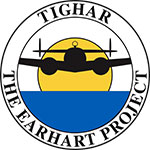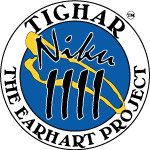Yesterday’s work continued setup and logistical arrangements, and began
the process of defining the problems.
Everyone went ashore except the Dive Team (who were diving) and Bill, who
was getting over his cold. This was not Bill’s choice; Ric and Jim ganged
up on him and insisted that he not over-extend himself this early in the
expedition. With luck he will be rarin’ to go tomorrow.
The first task was to locate the grave sites. Grave three was fairly easy
to find, and after examining it and doing a small-scale preliminary excavation
it’s quite certain that it is a grave. There are signs of a ring of small
coral rocks arranged around it – definitely human intervention. There may
be another grave nearby, and the remains of a Gilbertese house; if so, the
possibility is raised that this was part of the village, with family members
interred on the property as is the custom.
However, Grave 3 has a different orientation than the other possible grave.
It is oriented North/South, and traditional graves are always oriented East/West
– which the other one is. So the possibility still remains that it is,
in fact, an “outsider’s” burial. Excavation will commence tomorrow.
After lots of bushwacking Grave 4 was located, some distance from the location
indicated by the coordinates shot in in 1999. GPS is indeed a wonderful thing!
No more hacking around in the bush, shouting back and forth, lost most of
the time.
Chris Kennedy found the site, and although he was clearly audible, most
of the team could not get to him directly, the scaevola was so thick; they
had to go out to the beach and follow the trail he had cut in. The consensus
was that this site is not a grave, but is simply a coral slab tipped up when
a ren tree fell over. No more time will be spent at this site.
After lunch Ric, Tom, John, and Jim took a boat down to the Seven site,
and used GPS and the satellite photograph to locate it. They found it without
any trouble even though the scaevola was very heavy: they cut across from
the lagoon and intercepted the top of the short “arm” of the seven,
then backtracked and found the artifact site. No trace of the clearning done
in 1996 remained save some tattered remnants of surveyors’ tape, still faintly
orange.
Something John noticed which no one else ever had was a couple of places
where there were piles of clam shells. They didn’t walk there, and they didn’t
grow there, so someone brought them there to eat. This leads to the inference
of residence – if you’re simply grabbing a quick snack, you don’t roam
back into the bush but stay down by the lagoon shore where you harvest the
clams.
The Seven Site did produce the first casualty of the expedition. John was
cutting his way in when he started hollering and cussing. He’d disturbed
a bee’s nest, and they were not happy with his presence. He was stung right
on the tip of his nose. Everyone else scattered and was unstung.
Tom was very impressed with the degree of scaevola at the Seven Site. It
is far thicker and more difficult to work through than he had anticipated,
and that means walking a tightrope. You never want to disturb an archeological
site before you set it up and search it... but you can’t set up and search
this site without clearing scaevola (think multiflora rose and honeysuckle
and kudzu and everything else grown up lush and thick and tough) so you can
see what you’re doing... and clearing is a destructive process. Tom did,
though, get a look at the hole from a distance of about five meters (so as
not to walk about on anything delicate). He feels it’s about the right size
and shape to have had a skull dug out of it. Operations will commence at
the Seven Site tomorrow. The Seven Site artifacts are in the NW corner of ER29.
See The
Seven Site Project Bulletin for more information about this site; see
also Gallagher’s Clues Part
2 for the full analysis.
The Dive team got a lot done. They found the diving to be not difficult
at all except for the canyons, where there is a lot of surge back and forth.
They were able to search the reef face along WB7 and 8, including
the canyons, and found nothing. They had marked the site of the rust-colored
pixels with a buoy, guiding to it with GPS and the satellite photo. When
they arrived at the spot, Andrew yelled MARK and Walt looked down and said,
“Yup, this is the place, there it is.” “It” was a big
blodge of red algae, unfortunately; from the surface (approximately 30 foot
depth) it did indeed look like rust colored metal, but was not. No one was
surprised; it has always seemed completely incredible to us that something
metallic could survive and be visible from 300 miles up in that environment.
Some of the canyons are as much as 20 feet deep and 50 feet long. They are
also pretty murky, because the surging tends to stir up the silt and sand.
Walt was swimming up a particularly long one when, in the murk, he came face
to face with a large black tip reef shark. It’s hard to know who was scared
more; both of them turned and swam hard in the opposite direction! The dive
team isn’t having any problems with sharks; they are seeing gray whalers,
leopards, and blacktips, but so far nothing to give them any pause.
Tomorrow’s plan:
The Grave team will begin the excavation of Grave Three.
The Seven Site team will begin the awesome process of clearing the area
so archeological work can be done — veeerrrrryyyy carefully, to avoid
messing up the site.
The Dive team will continue to dive along the reef north of the Norwich
City, and (as time allows) the ledge. |



